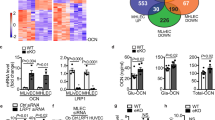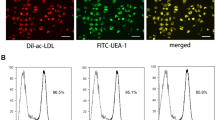Abstract
Aims
Diabetic osteoporosis (DOP) is the most common secondary form of osteoporosis. Diabetes mellitus affects bone metabolism; however, the underlying pathophysiological mechanisms remain unclear. Lectin-like oxidized low-density lipoprotein receptor-1 (LOX-1) expression is upregulated in conditions characterized by vascular injury, such as atherosclerosis, hypertension, and diabetes. Additionally, Notch, HIF-1α, and VEGF are involved in angiogenesis and bone formation. Therefore, we aimed to investigate the expression of Notch, HIF-1α, and VEGF in the LOX-1 silencing state.
Methods
Rat bone H-type vascular endothelial cells (THVECs) were isolated and cultured in vitro. Cell identification was performed using immunofluorescent co-expression of CD31 and Emcn. Lentiviral silencing vector (LV-LOX-1) targeting LOX-1 was constructed using genetic recombination technology and transfected into the cells. The experimental groups included the following: NC group, HG group, LV-LOX-1 group, LV-CON group, HG + LV-LOX-1 group, HG + LV-CON group, HG + LV-LOX-1 + FLI-06 group, HG + LV-CON + FLI-06 group, HG + LV-LOX-1 + LW6 group, and HG + LV-CON + LW6 group. The levels of LOX-1, Notch, Hif-1α, and VEGF were detected using PCR and WB techniques to investigate whether the expression of LOX-1 under high glucose conditions has a regulatory effect on downstream molecules at the gene and protein levels, as well as the specific molecular mechanisms involved.
Results
High glucose (HG) conditions led to a significant increase in LOX-1 expression, leading to inhibition of angiogenesis, whereas silencing LOX-1 can reverse this phenomenon. Further analysis reveals that changes in LOX-1 will promote changes in Notch/HIF-1α and VEGF. Moreover, Notch mediates the activation of HIF-1α and VEGF.
Conclusions
The activation of LOX-1 and the inhibition of Notch/HIF-1α/VEGF in THVECs are the main causes of DOP. These findings contribute to our understanding of the pathogenesis of DOP and offer a novel approach for preventing and treating osteoporosis.






Similar content being viewed by others
Data availability statement
Data will be made available on request.
References
Zimmet P, Alberti KG, Magliano DJ, Bennett PH (2016) Diabetes mellitus statistics on prevalence and mortality: facts and fallacies. Nat Rev Endocrinol 12(10):616–622. https://doi.org/10.1038/nrendo.2016.105
Parizad N, Baghi V, Karimi EB, Ghanei Gheshlagh R (2019) The prevalence of osteoporosis among Iranian postmenopausal women with type 2 diabetes: a systematic review and meta-analysis. Diabetes Metab Syndr 13(4):2607–2612. https://doi.org/10.1016/j.dsx.2019.07.036
Fajardo RJ (2017) Is diabetic skeletal fragility associated with microvascular complications in bone? Curr Osteoporos Rep 15(1):1–8. https://doi.org/10.1007/s11914-017-0341-8
Pagnotti GM, Styner M, Uzer G et al (2019) Combating osteoporosis and obesity with exercise: leveraging cell mechanosensitivity. Nat Rev Endocrinol 15(6):339–355. https://doi.org/10.1038/s41574-019-0170-1
Zheng ZW, Chen YH, Wu DY et al (2018) Development of an accurate and proactive immunomodulatory strategy to improve bone substitute material-mediated osteogenesis and angiogenesis. Theranostics 8(19):5482–5500. https://doi.org/10.7150/thno.28315
Kusumbe AP, Ramasamy SK, Adams RH (2014) Coupling of angiogenesis and osteogenesis by a specific vessel subtype in bone. Nature 507(7492):323–328. https://doi.org/10.1038/nature13145
Peng Y, Wu S, Li Y, Crane JL (2020) Type H blood vessels in bone modeling and remodeling. Theranostics 10(1):426–436. https://doi.org/10.7150/thno.34126
Maes C (2013) Role and regulation of vascularization processes in endochondral bones. Calcif Tissue Int 92(4):307–323. https://doi.org/10.1007/s00223-012-9689-z
Grosso A, Burger MG, Lunger A et al (2017) It takes two to tango: coupling of angiogenesis and osteogenesis for bone regeneration. Front Bioeng Biotechnol 5:68. https://doi.org/10.3389/fbioe.2017.00068
Jin P, Cong S (2019) LOX-1 and atherosclerotic-related diseases. Clin Chim Acta 491:24–29. https://doi.org/10.1016/j.cca.2019.01.006
Xu S, Ogura S, Chen J et al (2013) LOX-1 in atherosclerosis: biological functions and pharmacological modifiers. Cell Mol Life Sci 70(16):2859–2872. https://doi.org/10.1007/s00018-012-1194-z
Mehta JL, Chen J, Hermonat PL, Romeo F, Novelli G (2006) Lectin-like, oxidized low-density lipoprotein receptor-1 (LOX-1): a critical player in the development of atherosclerosis and related disorders. Cardiovasc Res 69(1):36–45. https://doi.org/10.1016/j.cardiores.2005.09.006
Pugh CW, Ratcliffe PJ (2017) New horizons in hypoxia signaling pathways. Exp Cell Res 356(2):116–121. https://doi.org/10.1016/j.yexcr.2017.03.008
Ramasamy SK, Kusumbe AP, Wang L, Adams RH (2014) Endothelial Notch activity promotes angiogenesis and osteogenesis in bone. Nature 507(7492):376–380. https://doi.org/10.1038/nature13146
Gao F, Mao T, Zhang Q et al (2020) H subtype vascular endothelial cells in human femoral head: an experimental verification. Ann Palliat Med 9(4):1497–1505. https://doi.org/10.21037/apm-20-121
Feng W, Liu S, Zhang C et al (2019) Comparison of cerebral and cutaneous microvascular dysfunction with the development of type 1 diabetes. Theranostics 9(20):5854–5868. https://doi.org/10.7150/thno.33738
Tousoulis D, Papageorgiou N, Androulakis E et al (2013) Diabetes mellitus-associated vascular impairment: novel circulating biomarkers and therapeutic approaches. J Am Coll Cardiol 62(8):667–676. https://doi.org/10.1016/j.jacc.2013.03.089
Shanbhogue VV, Hansen S, Frost M, Brixen K, Hermann AP (2017) Bone disease in diabetes: another manifestation of microvascular disease? Lancet Diabetes Endocrinol 5(10):827–838. https://doi.org/10.1016/S2213-8587(17)30134-1
Shanbhogue VV, Hansen S, Frost M et al (2016) Compromised cortical bone compartment in type 2 diabetes mellitus patients with microvascular disease. Eur J Endocrinol 174(2):115–124. https://doi.org/10.1530/EJE-15-0860
Zhang J, Pan J, Jing W (2020) Motivating role of type H vessels in bone regeneration. Cell Prolif 53(9):e12874. https://doi.org/10.1111/cpr.12874
Sawamura T, Kume N, Aoyama T et al (1997) An endothelial receptor for oxidized low-density lipoprotein. Nature 386(6620):73–77. https://doi.org/10.1038/386073a0
Pirillo A, Norata GD, Catapano AL (2013) LOX-1, OxLDL, and atherosclerosis. Mediat Inflamm 2013:152786. https://doi.org/10.1155/2013/152786
Shi Y, Vanhoutte PM (2017) Macro- and microvascular endothelial dysfunction in diabetes. J Diabetes 9(5):434–449. https://doi.org/10.1111/1753-0407.12521
Li L, Sawamura T, Renier G (2003) Glucose enhances endothelial LOX-1 expression: role for LOX-1 in glucose-induced human monocyte adhesion to endothelium. Diabetes 52(7):1843–1850. https://doi.org/10.2337/diabetes.52.7.1843
Benedito R, Roca C, Sörensen I et al (2009) The notch ligands Dll4 and Jagged1 have opposing effects on angiogenesis. Cell 137(6):1124–1135. https://doi.org/10.1016/j.cell.2009.03.025
Funding
Qi Zhang was supported by National Natural Science Foundation of China [81960173], National Research Incubation Project of Gansu Provincial People's Hospital [19SYPYB-4], Lanzhou Health and Wellness Commission [2021005].
Author information
Authors and Affiliations
Contributions
HL conceived and designed the experiments; performed the experiments; and wrote the paper. WG; YP performed the experiments. XL analyzed and interpreted the data. QZ conceived and designed the experiments; contributed reagents, materials, analysis tools or data; and wrote the paper.
Corresponding author
Ethics declarations
Conflict of interest
We have no known competing financial interests or personal relationships that could have appeared to influence the work reported in this study.
Ethical approval
This study has obtained approval from the Medical Ethics Committee of Gansu Provincial People’s Hospital and meets the ethical requirements. The approval number for this study is 2023-066. Original approval documents have been obtained and uploaded. These declarations are made to uphold transparency, adhere to ethical standards, and ensure the credibility and integrity of the research presented.
Human or animal rights
Research involving human participants of animals: The procedures met the experimental ethics requirements of the Gansu Provincial People's Hospital.
Additional information
Managed By' Massimo Porta.
Publisher's Note
Springer Nature remains neutral with regard to jurisdictional claims in published maps and institutional affiliations.
Rights and permissions
Springer Nature or its licensor (e.g. a society or other partner) holds exclusive rights to this article under a publishing agreement with the author(s) or other rightsholder(s); author self-archiving of the accepted manuscript version of this article is solely governed by the terms of such publishing agreement and applicable law.
About this article
Cite this article
Lei, H., Guo, W., Pan, Y. et al. LOX-1 regulation of H-type vascular endothelial cell regeneration in hyperglycemia. Acta Diabetol 61, 515–524 (2024). https://doi.org/10.1007/s00592-023-02224-7
Received:
Accepted:
Published:
Issue Date:
DOI: https://doi.org/10.1007/s00592-023-02224-7




